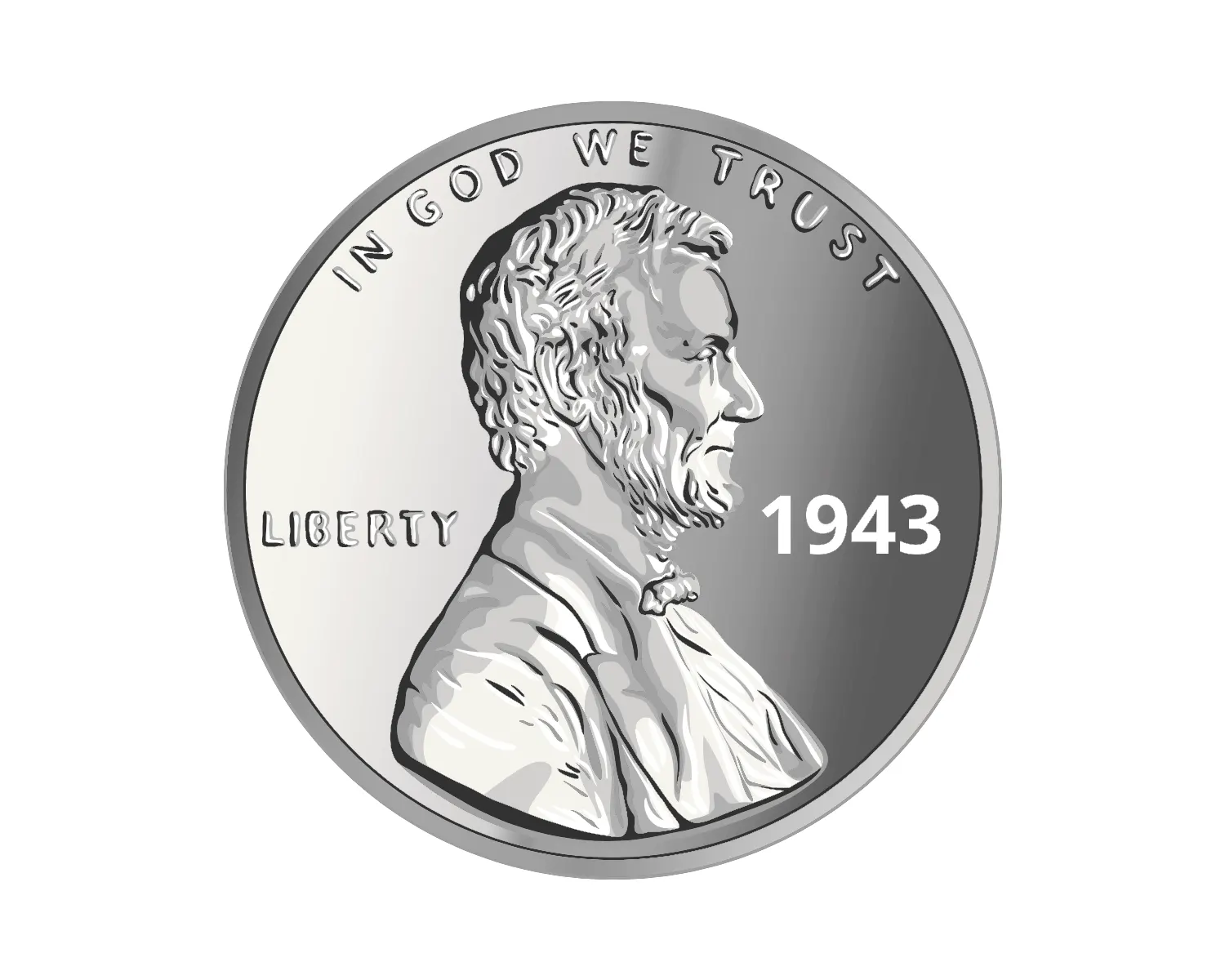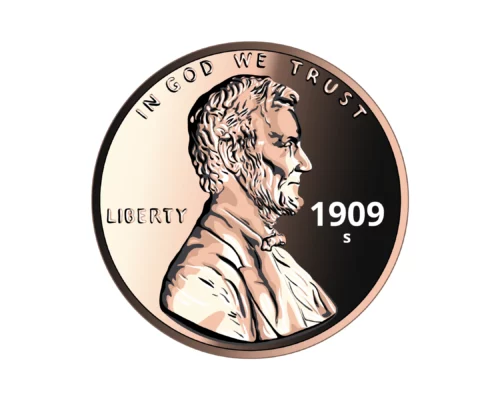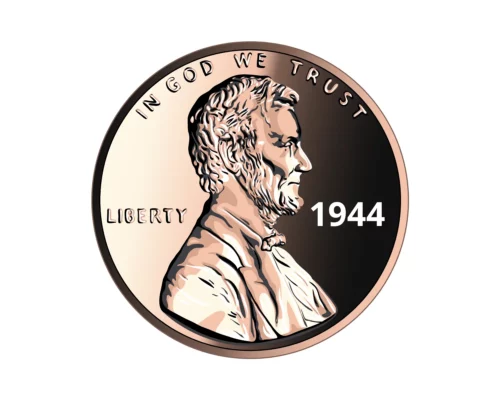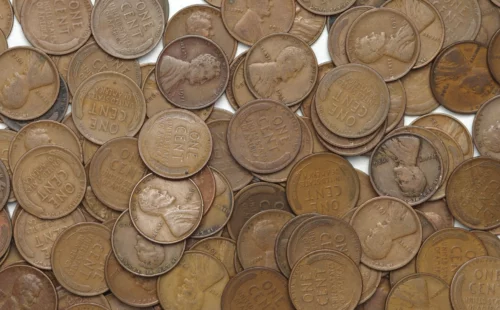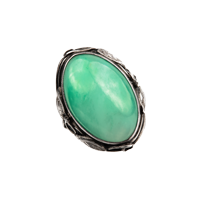1943 Wheat Penny Value
The history of the 1943 penny is a story of war, patriotism, and a little bit of luck. In the early 1940s, the United States was in the midst of World War II, and pennies were made with a steel core covered with copper to save on metals that were needed for the war effort. However, a few copper coins were accidentally minted, and these are now some of the most valuable pennies in existence. The few 1943 copper pennies that remain are cherished by collectors and are worth a small fortune. For those who come across one of these rare coins, it is a reminder of a time when patriotism was at an all-time high and everyone did their part to support the war effort.
Who Designed The 1943 Wheat Penny
The 1943 wheat penny was designed by Victor David Brenner, who is also responsible for the design of the Lincoln Cent. The coin was released during World War II as a result of a shortage of copper. The 1943 wheat penny is made of steel with a coating of zinc and is considered to be very rare. In fact, only about 40,000 were ever made! The coin gets its name from the fact that the reverse (tails side) features an image of wheat stalks. The wheat penny was minted for only one year and is now a collector’s item. Many people believe that the 1943 wheat penny is valuable because it was made during a time of national crisis. Others simply enjoy the coin for its unique history and design. Whatever the reason, the 1943 wheat penny remains a popular choice among collectors.
Types of 1943 Steel Pennies (Regular Strike)
Three types of 1943 steel pennies.
- 1943 unminted, minted at the (Philadelphia mint)
- 1943-D Lincoln penny (Denver mint)
- 1943-S Lincoln penny (San Francisco mint)
All three versions of this coin, the 1943, 1943-D, and the 1943-S are worth around 15 cents in average condition and in fine condition, can be worth a few dollars or more.
1943 steel cent
In 1943, the United States Mint produced a zinc-coated steel cent to replace the standard copper penny due to a shortage of the latter metal during World War II. The steel coins were produced at all three of the Mint’s facilities (Philadelphia, Denver, and San Francisco)
1943 Copper Cent
The unforeseen result of changing the composition of the planchet in 1943 was the 1943 bronze cents which comprised 95% copper and 5% zinc. When the 1942 manufacturing of cents ended, a few bronze planchets were still lodged in the tote bins the Mint staff used to feed the coin presses. When the bins were refilled with zinc-coated steel planchets at the start of manufacturing in 1943, these planchets went unreported. The rare wrong-planchet error treasures known to us were created when they were dislodged and fed into the coin presses with the “steel” blanks. Both the Philadelphia, Denver and San Francisco Mints experienced this occurrence.
1943 Tin Cent
A numismatic collector discovered a 1943 Lincoln cent struck on a planchet other than zinc-coated steel and not derived from the copper core that had become standard since the penny’s production in 1864 in 2019. The penny appears to have been made from a tin core and other base metals, and it is thought to have been created as a sample while the United States Mint tested coin metal options to conserve copper for the war effort during World War II. There is currently only one known copy of this coin.
How rare is a 1943 Steel Penny
Numismatic collectors are always looking for rare and valuable coins, and the 1943 steel penny is often thought to be one of the most valuable. However, the truth is that these pennies are actually not very rare at all. In fact, millions of them were minted, and they can easily be found in circulated condition. The value of a 1943 steel penny depends largely on its condition, but even a 1943, 1943-S, and 1943-D are normally only worth a couple of dollars in very fine condition at the least, they are worth between 10-15 cents. These prices are not to be confused with minting errors of the 1943 wheat cent, which we will touch on later. So, while searching for a rare 1943 steel penny may be fun, don’t get your hopes up too much – you’re not likely to find a fortune.
What makes a 1943 wheat penny valuable
A 1943 wheat penny is valuable for a few reasons. First, minting errors during that year led to some coins being made with a bronze cent planchet instead of the standard brass planchet. Second, the mint also produced a small number of 1943 pennies on zinc-coated steel planchets. These “zinc cents” are even more rare than the steel cents. Finally, due to high demand during World War II, the mint also produced a small number of pennies on silver planchets, and there is also what is known as a 1943 tin cent, also the result of a minting error with planchets. Aside from minting errors, 1943 Lincoln cents in exceptional condition are always valuable. Determining the quality of your coin would normally constitute an MS66 or higher grade and would require submitting your penny to an institution like PGCS.
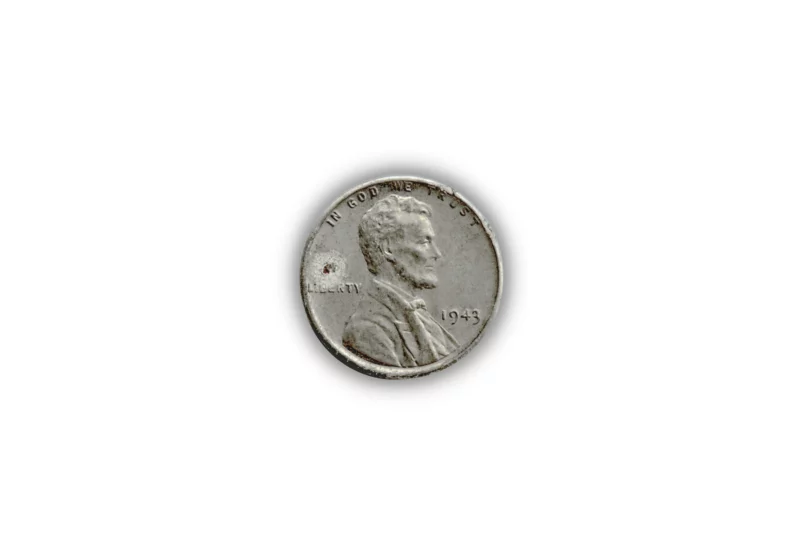
1943 Wheat Penny Values
Wheat pennies have a wide range of values. The 1943, 1943-S, and 1943-D standard mintage of these coins can range from 15 cents to a few dollars for coins in fine condition. Coins graded MS66 or higher are typically worth significantly more. However, making such a determination would necessitate submitting your coins to an agency such as PGCS. There are numerous known errors, the most valuable of which involve using incorrect metal planchets during manufacturing. Mintage errors in 1943 can be extremely valuable, so make sure you understand the distinctions between standard wheat pennies produced by mints in 1943 and mintage errors produced by mints. If you come across a 1943, 1943-S, or 1943-D in bronze color, it may be valuable and worth sending to PGCS for grading.
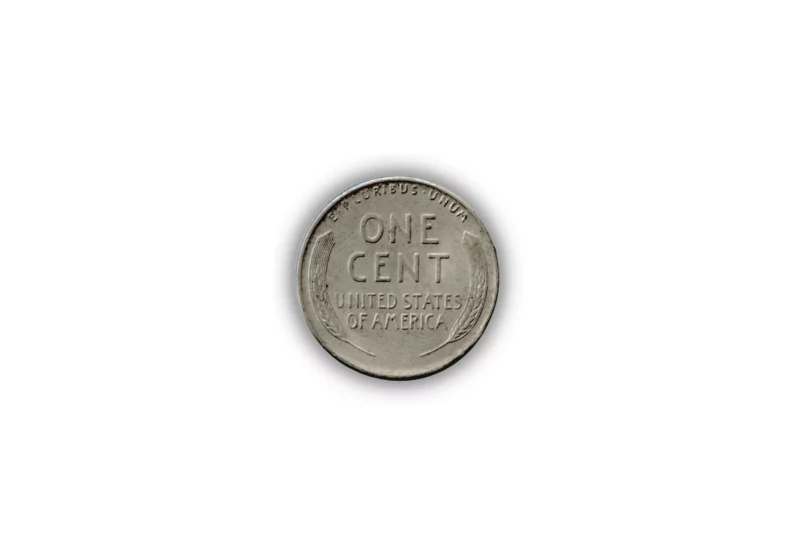
How much is a 1943 no mint mark wheat penny worth?
A 1943 wheat penny with no mint mark, Philadelphia mint, is the most common of the 1943 pennies and is worth around 15 cents in average condition and up to a few dollars for nongraded coins in fine condition. Graded versions of this coin need to place MS66 or higher to be valuable generally.
How Many Unmarked 1943 Wheat Pennies Were Made
684,628,670 1943 1943 (Regular Strike)
how much is a 1943-d steel penny worth
A 1943-D wheat penny from the Denver mint is worth around 15 cents in average condition and up to a few dollars in fine condition for an ungraded version of this coin. Highly graded versions of this coin can also fetch a high price, but only if they are MS66 or higher. Versions of this coin in the 67MS+ range can sell for hundreds or even a thousand dollars or more.
How Many Denver mint 1943-D Wheat Pennies Were Made
217,660,000 – 1943-D (Regular Strike)
how much is a 1943-S steel penny worth
1943-S 1C (Regular Strike) wheat penny with a San Francisco mint mark is the most common of the 1943 pennies and is worth around 15 cents in average condition and up to a few dollars for nongraded coins in fine condition. Like the other regular strike versions of this coin, the 1943-S needs to be graded and placed MS66 or higher to be valuable generally, with prices in the thousands for coins that are graded highly
How Many San Francisco mint 1943 Wheat Pennies Were Made
191,550,000 – 1943-S (Regular Strike)
What is the 1943 wheat penny error
The 1943 wheat penny error is a coin that was mistakenly minted on a Bronze planchet instead of a zinc-coated steel planchet. Because of this, the coin is significantly more valuable than a regular 1943 wheat penny. Only a few of these coins are known to exist and are highly sought after by collectors. The most famous coin was sold at auction for $1.7 million in 2010. While the 1943 wheat penny error is extremely valuable, it is important to note that it is also very rare. Among these errors are several versions—the bronze planchet 1943-D, the 1943-S, and the 1943 Philadelphia, un-minted version. The 1943-D bronze planchet is the most valuable, as only one known copy exists. It recently resold in 2021 for $840,000.
How do I know if my 1943 penny is rare
There are a few things that you can look for when trying to determine if your 1943 penny is rare:
- Check to see if your penny has a steel core. In 1943, the US mint switched from using copper to using steel due to a shortage of copper. Copper core versions of the 1943 coin are worth exponentially more than the steel core versions as they are considered a rare mintage error.
- Check the condition of your penny. If it is in good condition, it is likely to be more valuable than a damaged or worn penny.
If you think you may have a rare 1943 penny, it is always a good idea to consult with a professional numismatist to get an expert opinion.
1943 wheat penny worth a million dollars
A 1943-D Bronze, BN Regular Strike (95% Copper, 5% Tin and Zinc) Lincoln cent has a rough value of around one million dollars. 1.7 million dollars was paid for this coin in 2010. $840,000 was paid for it at auction in 2021. A 1943 bronze Lincoln cent graded Mint State 63 Red was reportedly sold in a private agreement for one million dollars. However, the 1943-D bronze penny has the highest public price to date.
1943 copper penny $1.7 million
The 1943-D Bronze penny was sold in 2010 through a private sale for 1.7 million dollars. This coin was resold in 2021 for $840,000. There is one known copy. Other mintage versions of this error coin have sold for six-figure amounts. However, the 1943-D remains the most ever paid for a 1943 penny.
Which 1943 steel penny is valuable
Coins in exceptional condition from the 1943 steel strikes of this coin are valuable. If the coin has a mintage error, such as a stamping error or another type of mintage error, you could have a valuable 1943 regular strike Lincoln cent in addition to the condition. This would necessitate a grade of MS66 or higher and, more commonly, a grade of MS67 or higher.
How do I know if my 1943 penny is steel
Using a magnet is the simplest way to determine if a 1943 cent is made of steel. If it sticks to the magnet, it is most likely made of steel. Certain metals, such as aluminum, copper, brass, lead gold, and silver, do not naturally attract magnets. The second way is to examine the color of the surface. A steel penny from 1943 will have a silver-toned surface that resembles white metal, such as steel or silver. It may also oxidize differently, similar to the examples above.
Should I Have My 1943 Wheat Penny Graded
Having your 1943 wheat cent graded can make your penny more valuable. However, that value will only depend on the condition of your coin and if it is a regular strike or a mintage error. If your coin is a regular strike 1943, 1943-D, or 1943-S, then having it graded will only make sense if it is in exceptional mint state condition and generally graded at MS (mint state) MS66 or higher. If the penny contains a mintage error, then it may not need to be in the finest possible condition to be valuable. Then it becomes important to familiarize yourself with all the possible errors that exist with the 1943 cent to decide if having it graded is worth the expense.
What Is The Most Ever Paid For A 1943 Wheat Penny
The most ever paid for a 1943 Lincoln wheat penny was $1,700,000 through a private agreement. The coin was a 1943-D Bronze Cent PCGS MS64BN. It was sold in 2010. At auction, the most ever paid for a 1943 penny was $840,000 for the same coin, the 1943-D Bronze Cent, MS64 Brown, in 2021. It was the only copy of this 1943 minting from the Denver mint from a bronze planchet.
What Are 1943 Wheat Pennies Made Of
The regular strike 1943 steel penny is made of 99% steel with a thin layer of zinc.
How Much Did The 1943 Wheat Penny Cost To Mint
Although the United States penny has a higher mintage cost than its face value, the 1943 steel penny only cost about one-tenth of a dollar, implying that the United States profited from minting the 1943 steel penny.
How Much Does A 1943 Steel Penny Weight
The 1943 regular strike steel penny weights 2.70 grams. Less than a standard wheat penny, made with a copper core, which weighs 3.11 grams.
1943 Wheat Penny Counterfeits
While some counterfeits are easy to spot, others can be pretty convincing. 1943 wheat penny mintage errors can be pretty valuable, as are coins in mint state conditions, and as a result, counterfeit versions of these coins will always be made when there are coins of value. As a result, it is essential to be aware of the differences between genuine and fake 1943 wheat pennies. Collectors should exercise caution when purchasing these coins and consult with an expert if they have any doubts about a coin’s authenticity. Other things are sometimes done to these coins to make these coins appear more legitimate, such as slabbing coins, which refers to coins sealed in clear plastic containers, or presenting these coins as having been graded by legitimate coin grading agencies like PGCS but are counterfeit grading slabs, as even these plastic coin grading packages can be counterfeited.
where can i sell my 1943 steel penny
You may be able to sell your 1943 steel penny for a relatively high price depending on its condition. Many pennies from this year are worth more than their face value due to their scarcity. While most steel pennies were produced in 1943, a small number of copper pennies were also minted this year. Copper pennies from 1943 are especially valuable since they are very rare. If you have a copper penny from 1943, you may be able to sell it for hundreds or even thousands of dollars. Contact a professional coin dealer to get an accurate appraisal of your penny’s value. You can also find out how much your penny is worth by looking up its value online. If you are interested in selling your coins, contact us for more information
More Read and information
Author, coin specialist, and numismatist James Bucki has written many excellent articles on coins and pennies. He writes for The Spruce Crafts. Professional grading service PCGS is a great resource and performs world-class grading services for coins. NGC also provides expert coin guides and grading services. They also offer a world-class price guide for graded coins.

